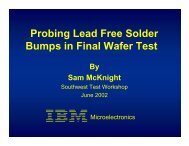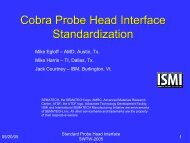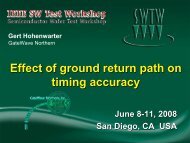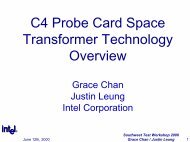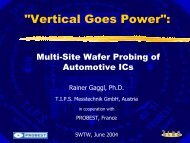Evaluation of Low Pressure MEMS Probes - Semiconductor Wafer ...
Evaluation of Low Pressure MEMS Probes - Semiconductor Wafer ...
Evaluation of Low Pressure MEMS Probes - Semiconductor Wafer ...
You also want an ePaper? Increase the reach of your titles
YUMPU automatically turns print PDFs into web optimized ePapers that Google loves.
June 7-10, 2009<br />
San Diego, CA<br />
<strong>Evaluation</strong> <strong>of</strong> <strong>Low</strong> <strong>Pressure</strong> <strong>MEMS</strong><br />
<strong>Probes</strong><br />
Probelogic Inc<br />
Scott Clegg, Krzyszt<strong>of</strong> Dabrowiecki<br />
Probelogic<br />
Shoichi Asanuma<br />
TOTO<br />
Darren James<br />
Rudolph Technologies
Outline<br />
• Design Review<br />
– Specifications<br />
– Resultant Design<br />
• Design <strong>Evaluation</strong><br />
– Force vs deflection<br />
– Life Tests<br />
–Scrub<br />
• Conclusion<br />
June 7 to 10, 2009<br />
IEEE SW Test Workshop 2
Design Specification<br />
• User replaceable<br />
probes<br />
• Compatible with<br />
existing technology<br />
• Reliable solution<br />
• Chose a buckling<br />
beam type design<br />
• Precision ceramics<br />
June 7 to 10, 2009<br />
IEEE SW Test Workshop 3
Standard<br />
Machinable Ceramics Review<br />
Hole Shape: Critical for fine-pitch hole integrity and reliability<br />
All Hole Diameters:<br />
0.11mm<br />
Hole<br />
Pitch:<br />
0.15mm<br />
Hole Pitch:<br />
0.13mm<br />
Test Die<br />
Finer grain<br />
ceramic<br />
June 7 to 10, 2009<br />
IEEE SW Test Workshop 4
Polycrystalline Drill Bits – Precision Drilling<br />
Flat tool prepared on the drilling machine<br />
OD: 0.035mm<br />
1.2<br />
工 具 径 の 精 度 とばらつき ~ 径 の 分 布 ~<br />
Distribution <strong>of</strong> Tool OD<br />
Frequency 確 率 密 度 関 Function 数 f(x)<br />
1.0<br />
0.8<br />
0.6<br />
0.4<br />
0.2<br />
0.0<br />
June 7 to 10, 2009<br />
30 31 32 33 34 35 36 37 38 39 40<br />
工 具 径 [μm ]<br />
(um)<br />
IEEE SW Test Workshop 5
Surface Roughness <strong>of</strong> Inner Hole Wall<br />
Standard<br />
Surface roughness<br />
<strong>of</strong> hole inner wall<br />
Test Die<br />
Ra (um)<br />
Test<br />
Die<br />
Std.<br />
0.1059<br />
0.4433<br />
June 7 to 10, 2009<br />
IEEE SW Test Workshop 6
Upper Die Measurements<br />
June 7 to 10, 2009<br />
IEEE SW Test Workshop 7
<strong>Low</strong>er Die Measurements<br />
Mechanical drilling <strong>of</strong> machinable ceramic<br />
June 7 to 10, 2009<br />
IEEE SW Test Workshop 8
Buckling Beam Review<br />
Probe Made from 2mil Wire<br />
Probe fabricated from 2mil wire<br />
BCF~2gm/mil<br />
High Stress<br />
Concentrations<br />
Limit Force and<br />
Overdrive<br />
Coined from wire<br />
Coined from a slender wire.<br />
Bending in curved section<br />
June 7 to 10, 2009<br />
IEEE SW Test Workshop 9
Observations Regarding<br />
Standard Buckling Beam <strong>Probes</strong><br />
• Spring rate <strong>of</strong> probe is driven by<br />
– Length and <strong>of</strong>fset <strong>of</strong> coined section<br />
– Width <strong>of</strong> coined section<br />
• Stress concentrations<br />
– Transitions<br />
– Micro-hole constraints<br />
• Pitch Limitation<br />
– Wire size<br />
– Cross-sectional length <strong>of</strong> coined section<br />
June 7 to 10, 2009<br />
IEEE SW Test Workshop 10
MEMs Probe Design<br />
• Design Constraints<br />
– Multiple layer photolithographic & plating process<br />
– Minimize layer count<br />
– Maximum stress less than ½ ultimate strength at<br />
greater than 5mil OD<br />
– Minimize cross-section for fine pitch applications<br />
June 7 to 10, 2009<br />
IEEE SW Test Workshop 11
• Long slender probe<br />
–Three layers<br />
• Fine pitch (less than<br />
60um)<br />
• <strong>Low</strong>er production costs<br />
– Stress concentration<br />
• Limits spring rate<br />
–<strong>Low</strong> BCF<br />
• 1.0 to 1.5 gm from 50um<br />
to 75um OD<br />
• Maximum 2.0 gm<br />
Final Design<br />
June 7 to 10, 2009<br />
IEEE SW Test Workshop 12
Probe Tip Contact Force<br />
No overdrive<br />
2.5 mils overdrive<br />
June 7 to 10, 2009<br />
IEEE SW Test Workshop 13
Will <strong>Low</strong> Force Work?<br />
• Build test vehicle<br />
– Fully functional<br />
– 60um pitch<br />
• Evaluate<br />
– Life time contact resistance<br />
– Scrub<br />
• Depth<br />
• Alignment<br />
June 7 to 10, 2009<br />
IEEE SW Test Workshop 14
MEMs <strong>Probes</strong><br />
• Unique probe tip geometry<br />
• Superior material properties<br />
• Prime manufacturing tolerances<br />
June 7 to 10, 2009<br />
IEEE SW Test Workshop 15
Test Procedure<br />
• <strong>Wafer</strong> scrub analysis<br />
– Scrub wafer at 50um and 75um overdrive<br />
– Measure scrub position and depth with<br />
<strong>Wafer</strong>WoRx 300<br />
• CRES as a function <strong>of</strong> touch downs<br />
– Measure test vehicle path resistance with PRVxII<br />
– Scrub on wafer multiple times at 50um overdrive<br />
– Periodically remeasure path resistance with<br />
PRVxII<br />
June 7 to 10, 2009<br />
IEEE SW Test Workshop 16
<strong>Wafer</strong> Scrub Analysis<br />
• Scrub wafer at 50um<br />
and 75um OD<br />
• Use <strong>Wafer</strong>WoRx 300<br />
system<br />
– Measure scrub depth<br />
pr<strong>of</strong>iles<br />
– Measure scrub position<br />
June 7 to 10, 2009<br />
IEEE SW Test Workshop 17
<strong>Wafer</strong> Scrub Analysis<br />
June 7 to 10, 2009<br />
IEEE SW Test Workshop 18
<strong>Wafer</strong> Scrub Analysis<br />
June 7 to 10, 2009<br />
IEEE SW Test Workshop 19
<strong>Wafer</strong> Scrub Analysis<br />
June 7 to 10, 2009<br />
IEEE SW Test Workshop 20
<strong>Wafer</strong> Scrub Analysis<br />
June 7 to 10, 2009<br />
IEEE SW Test Workshop 21
<strong>Wafer</strong> Scrub Analysis<br />
June 7 to 10, 2009<br />
IEEE SW Test Workshop 22
Summary <strong>of</strong> Readings<br />
• Scrub depth – 0.18um ± 0.03um (one sigma)<br />
• Scrub length – 15um ± 7um (one sigma)<br />
• Scrub width – 12um ± 4um (one sigma)<br />
• Scrub alignment – 7um ± 4um (one sigma)<br />
Comments:<br />
All measurements at 75um OD<br />
Probe tip width 8um<br />
Rejected alignment outliers<br />
June 7 to 10, 2009<br />
IEEE SW Test Workshop 23
Life Testing: CRES<br />
June 7 to 10, 2009<br />
IEEE SW Test Workshop 24
Conclusion<br />
• Design constraints led to low force probe<br />
design with maximum force <strong>of</strong> ~2gm<br />
• Probe penetrates wafer .18um for 75um OD<br />
yielding good wafer contact<br />
• Small probe tip contact with hard plated metal<br />
yields low, consistent, and stable CRES<br />
• Path resistance drops to less than 2 Ohms<br />
when probing aluminum wafer<br />
• New drill technology and machinable ceramic<br />
material aids in improved alignment accuracy<br />
June 7 to 10, 2009<br />
IEEE SW Test Workshop 25
• Rod Doe<br />
Acknowledgements<br />
– Senior Engineer<br />
– Rudolph Technologies<br />
• Shoichi Asanuma<br />
- TOTO Advanced Ceramics<br />
• Additional data<br />
regarding hard<br />
ceramics will be<br />
presented during<br />
Wednesday morning<br />
session<br />
June 7 to 10, 2009<br />
IEEE SW Test Workshop 26


